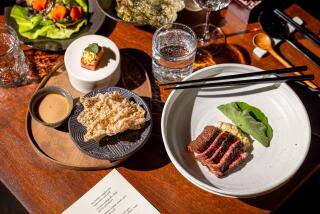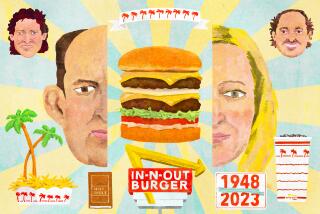A hunger for change
On Sept. 16, 1912, the very first issue of USC’s Daily Southern Californian (now known as the Daily Trojan) declared on page 3: “Cafeteria Improved.” The primary advancement was “shiny new devises for keeping eatables hot,” and the article was unsigned, possibly to save the writer from a big razzing by classmates.
Students, after all, have always complained about food. They griped in the Middle Ages and they griped in Colonial days. Los Angeles collegians may have been the first to gripe about their campus cafeteria food after local schools adopted the concept of self-service with trays from the commercial cafeteria, invented here in 1905.
It seems likely that students also complained about alternatives to the cafeteria. Between 1880 and 1887, when the USC campus was a remote place south of town, it didn’t have a dining hall, and some students had to rely on a horse-drawn tamale wagon for lunch. Talk about a limited menu.
For decades, many students at USC (and Occidental College as well) lived in boardinghouses or ate at restaurants on a meal-ticket plan. It’s unknown whether any menus survive, but some of those places must have been serving a lot of watery soups and leftover-based “rice molds” and “macaroni rings,” because other, competing, boardinghouses made a point of advertising “substantial” food. Some students living in rooming houses may have been taking matters into their own hands, dining on fruit and sandwiches, which might explain why markets advertised in student publications long before restaurants did.
On special occasions, late 19th and early 20th century students might find themselves eating rather sophisticated food, the sort of Frenchified, multi-course meals that upscale restaurants served until Prohibition, typically beginning with oysters and soup and proceeding through several meat courses.
That sort of dining waned during the 1920s and died miserably in the Depression, but consider this menu from a 1909 USC football banquet: oyster cocktail, consomme a la princess (with sweet peas and diced chicken breast), striped bass a la Normande (in cream sauce), stuffed turkey and pastries. Apparently, those were the days when a tough guy didn’t have a problem eating consomme a la princess.
No printed menus appear to have survived from local college dining facilities before the 1930s, when menus show up listing the frumpy, Depression-era food the whole country was eating at the time. On Oct. 22, 1938, the USC cafeteria offered creamed tuna on toast, raviolis with chicken livers or frankfurters with sauerkraut for 25 cents. If you wanted to splurge and pay 35 cents, you had grander choices such as pork chops with applesauce, sardines with potatoes or a Spanish omelet.
In 1940, the director of the Pomona College dining halls happened to write down, on the backs of postcards, some of her daily specials that year: rice croquettes with chipped beef, vegetable meat rolls with mushroom gravy and chicken fricassee with dumplings.
Some peculiar sandwiches show up on 1930s college menus: sardine and tomato; Swiss cheese and currant jelly; peanut butter with currant jelly and potato chips. They may sound like the kind of thing students tend to throw together while cramming, but they were actually standard tearoom sandwiches at the time.
An early 20th century belief that eggs were the perfect protein must explain the egg drinks on a 1938 USC menu -- egg-enriched shakes and malts, even egg lemonade.
When Occidental College moved from Highland Park to Eagle Rock in 1914, it opened the Occidental Cafe in Fowler Hall under Mrs. A. Ekloff, who had trained in Swedish schools (as a nutritionist, it would seem). “The College dining-room has been serving up plain, wholesome, but plentiful meals,” the student weekly reported, sunnily describing them as “a wonder and a delight to the hungry hordes from Swan Hall,” the men’s dormitory.
But a few issues later, a student complained that Mrs. Ekloff’s food was way too plain and wholesome. There were “too much lettuce, greens, cauliflower and squash” and “meat that cannot be found on a plate without the aid of a microscope.”
The real reason students always complain about college food is that it’s rarely what they’d choose. Growing bodies, it seems, yearn for mass quantities of protein and, above all, sugar, starch and fat. After all, fudge was invented by college girls, probably at Vassar, in the 1880s.
Indeed, pigging out on sweets has always been a college activity. In 1899, the first dining place to advertise in the SVC Student -- the high-minded literary monthly of Saint Vincent’s College, the predecessor to Loyola University -- was Smith’s Ice Cream and Soda, at 333 S. Spring St. At Occidental, victims of Mrs. Ekloff’s healthful food could sneak over to Bryson’s on Eagle Rock Boulevard, which advertised “Ice Cream, Tamales etc.” In 1912, the canny Peter Pan Sweet Shop was located right at the USC trolley stop on Jefferson Avenue: “Where You Get Off the Car,” as its ads seductively put it.
The students’ own ideal cuisine may have been perfectly envisioned by one of the sponsors -- a sweetshop named Pin Ton -- of a 1912 cookbook benefiting the USC YWCA. The book offered this “Recipe for the Blues”: “Go straight to Pin Ton. Get one pound Sin Igual chocolates, one pound buttermilk chocolates, one pound cream almonds, mix well together. Take at one dose. Then drink one glass grape phosphate. Repeat dose daily.”
Since the 1930s, college dining has continued the age-old struggle between frugal, wholesome food on one hand and cheap thrills on the other, the cafeteria or dining hall versus the off-campus snack shops. A decisive change came in 1987, when USC allowed a Carl’s Jr. to open, making it the first college in the nation to have a fast-food franchise on campus. This was a controversial move at the time, but colleges across the country have followed suit, giving their students a wider range of choices than ever -- for good or ill, depending on your point of view.
Partly because of this competition, partly because the country has become more sophisticated in its tastes, even the cafeterias and dining halls have been improving the attractiveness and variety of their food. University officials finally figured out that they can’t get away with mystery meat and stewed tomatoes the way they once could.
charles.perry@latimes.com
More to Read
Start your day right
Sign up for Essential California for news, features and recommendations from the L.A. Times and beyond in your inbox six days a week.
You may occasionally receive promotional content from the Los Angeles Times.






